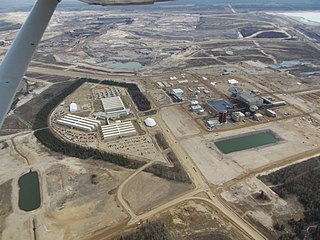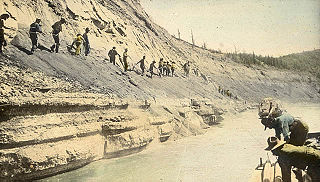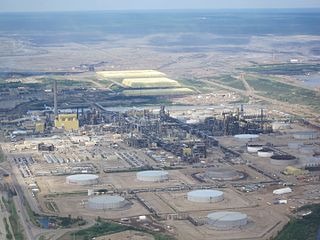 W
WThe Athabasca oil sands, also known as the Athabasca tar sands, are large deposits of bitumen or extremely heavy crude oil, located in northeastern Alberta, Canada – roughly centred on the boomtown of Fort McMurray. These oil sands, hosted primarily in the McMurray Formation, consist of a mixture of crude bitumen, silica sand, clay minerals, and water. The Athabasca deposit is the largest known reservoir of crude bitumen in the world and the largest of three major oil sands deposits in Alberta, along with the nearby Peace River and Cold Lake deposits.
 W
WAlbian Sands Energy Inc. is the operator of the Muskeg River Mine and Jack Pine Mine, an oil sands mining project located 75 kilometres (47 mi) north of Fort McMurray, Alberta, Canada. It is a joint venture between Shell Canada (10%), CNRL (70%) and Chevron Canada (20%). The company's legal headquarters are located in the Shell Tower in Calgary, Alberta. Albian Sands got its name from the Albian Boreal Sea which, during the Albian stage of the Cretaceous, moved over the McMurray sands and deposited a blanket of marine shale on its floor which trapped the hydrocarbons of the McMurray Formation. The oil sands resources of the Muskeg River Mine are a legacy of the Albian Sea.
 W
WAthabasca is a novel by Scottish author Alistair MacLean, first published in 1980. As with the novel Night Without End, it depicts adventure, sabotage and murder in the unforgiving Arctic environment. It is laid in the oilfields and oil sands fields of Alaska and Canada and includes a considerable amount of technical detail on the operations.
Athabasca Oil Corporation is a Canadian energy company with a focused strategy on the development of thermal and light oil assets. Situated in Alberta's Western Canadian Sedimentary Basin, the Company has amassed a significant land base of extensive, high quality resources. Athabasca's common shares trade on the TSX under the symbol "ATH".
 W
WBitumount is an abandoned industrial site on the east bank of the Athabasca River about 90 kilometres (60 mi) north of Fort McMurray in northeastern Alberta, Canada. Between 1925 and the 1950s, it was the site of early attempts to extract bitumen from the Athabasca oil sands that contributed to the development of commercially viable extraction processes. The site closed permanently in 1958. Some of the structures at Bitumont were declared Provincial Historic Resources in 1974. As of 2017, the buildings are deteriorating.
 W
WKarl Adolf Clark was a chemist and oil sand researcher. He is best known for perfecting a process that uses hot water and reagents to separate bitumen from oil sands.
 W
WThe Kearl Oil Sands Project is an oil sands mine in the Athabasca Oil Sands region at the Kearl Lake area, about 70 kilometres (43 mi) north of Fort McMurray in Alberta, Canada. The project is being developed in three phases with the first phase completed mid-2013.
 W
WThe Long Lake oil sands upgrader project is an in situ oil extraction project near Anzac, Alberta, 40 km (25 mi) southeast of Fort McMurray in the Athabasca oil sands region of Alberta.
 W
WThe McMurray Formation is a stratigraphic unit of Early Cretaceous age of the Western Canada Sedimentary Basin in northeastern Alberta. It takes the name from Fort McMurray and was first described from outcrops along the banks of the Athabasca River 5 kilometres (3.1 mi) north of Fort McMurray by F.H. McLearn in 1917. It is a well-studied example of fluvial to estuarine sedimentation, and it is economically important because it hosts most of the vast bitumen resources of the Athabasca Oil Sands region.
 W
WOil Sands Karaoke is a 2013 feature documentary film directed by Charles Wilkinson. The film follows five people working in or around the infamous Athabasca oil sands of Northern Alberta as they compete in a karaoke contest held at local watering hole Bailey's Pub. The film was produced by Wilkinson and Tina Schliessler, and executive produced by Kevin Eastwood and Knowledge Network's Murray Battle.
 W
WSyncrude Canada Ltd. is one of the world's largest producers of synthetic crude oil from oil sands and the largest single source producer in Canada. It is located just outside Fort McMurray in the Athabasca Oil Sands, and has a nameplate capacity of 350,000 barrels per day (56,000 m3/d) of oil, equivalent to about 13% of Canada's consumption. It has approximately 5.1 billion barrels (810,000,000 m3) of proven and probable reserves situated on 8 leases over 3 contiguous sites. Including fully realized prospective reserves, current production capacity could be sustained for well over 90 years.
 W
WThe Trans Mountain Pipeline System, or simply the Trans Mountain Pipeline, is a pipeline that carries crude and refined oil from Alberta to the coast of British Columbia, Canada. "Trans Mountain Pipeline System" and "Trans Mountain Expansion Project", TMX, are since August 31, 2018, part of "Trans Mountain Corporation", a wholly owned subsidiary of the Canada Development Investment Corporation (CDIC), that is accountable to the Parliament of Canada. Until the purchase by the CDIC, it was owned by the Canadian division of Houston, Texas-based Kinder Morgan, IncKinder Morgan Energy Partners. The pipeline has been in use since 1953. It is the only pipeline to run between these two areas.